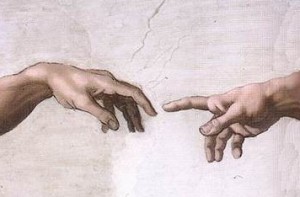The Sistine Chapel: A Liturgical Classroom
 On October 31, 2012, Pope Benedict XVI observed the 500th anniversary of the Sistine Chapel by offering a prayer—celebrating Vespers beneath Michelangelo’s famed frescoes of biblical stories including, most famously, the Creation of Adam.
On October 31, 2012, Pope Benedict XVI observed the 500th anniversary of the Sistine Chapel by offering a prayer—celebrating Vespers beneath Michelangelo’s famed frescoes of biblical stories including, most famously, the Creation of Adam.
The Holy Father called the chapel a “liturgical classroom,” explaining that “It is as if during the liturgical action, the entire symphony of figures comes alive, certainly in the spiritual sense, but also…in the aesthetic sense. The Sistine Chapel, encompassed in prayer, is even more beautiful, more authentic; it reveals all of its treasures.”
He mused about those who saw the ceiling for the first time, after Michelangelo had worked for four years to create his masterpiece. The Pope quoted Giorgio Vasari, a contemporary of Michelangelo’s who was himself an Italian artist, writer and architect, and who is famed for his biographies of Renaissance artists. Vasari said of the Sistine, “This work has been, and truly is, the lamp of our art, which has given so much good and light to the art of painting; which was enough to illuminate the world.”
The Sistine Chapel is unusual in that it has no exterior doors; it is accessible only by way of other rooms in the Apostolic Palace. A high rectangular building with no external adornments to signal the majesty which can be found in its interior, the Sistine Chapel is exactly the dimension of the Old Testament Temple of Solomon.
The ceiling, more than 5,000 square feet, was painted by Michelangelo and includes ancestors of Christ (prophets), and nine stories from the Book of Genesis including the Creation, Adam and Eve in the Garden of Eden, and the Great Flood. The wall above the altar was painted by Michelangelo and depicts the Last Judgment. Other major works on the walls include:
The Stories of Moses on the southern wall:
- Moses Leaving to Egypt by Pietro Perugino and assistants
- The Trials of Moses by Sandro Botticelli and his workshop
- The Crossing of the Red Sea by Cosimo Rosselli, Domenico Ghirlandaio or Biagio di Antonio Tucci
- Descent from Mount Sinai by Cosimo Rosselli or Piero di Cosimo
- Punishment of the Rebels by Sandro Botticelli
- Testament and Death of Moses by Luca Signorelli or Bartolomeo della Gatta
The Stories of Jesus on the northern wall, including:
- Baptism of Christ by Pietro Perugino and assistants
- Temptation of Christ by Sandro Botticelli
- Vocation of the Apostles by Domenico Ghirlandaio
- The Sermon on the Mount, attributed to Cosimo Rosselli
- The Delivery of the Keys by Pietro Perugino
- The Last Supper by Cosimo Rosselli
The eastern wall includes two works: the Resurrection of Christ by Hendrik Van den Broeck, and Disputation over Moses’ Body by Matteo da Lecce.
* * * *
Since the papacy of Sixtus IV, the Sistine Chapel has served as a place of prayer and a meeting place. It is here, in the Sistine, where the College of Cardinals gathers to elect a new pope. On a tour of the Apostolic Palace I was moved by a small, sparsely furnished room near the Sistine which has been called the “Room of Tears”—so named because a newly elected pontiff, cognizant of the great weight which has just been placed on his shoulders, will likely be moved to tears. When a new pope is elected, it is in this room that he will be dressed in his papal vestments for the first time, before emerging to greet the crowd from his window. At the time the Cardinals gather to cast their votes, hanging ready in the Room of Tears will be three white vestments, sized small, medium and large.
* * * *
If you’ve never seen the Sistine Chapel, you will certainly enjoy the Virtual Tour available on the Vatican’s website here. Use your cursor to move around the room, to view the frescoes from every angle.

